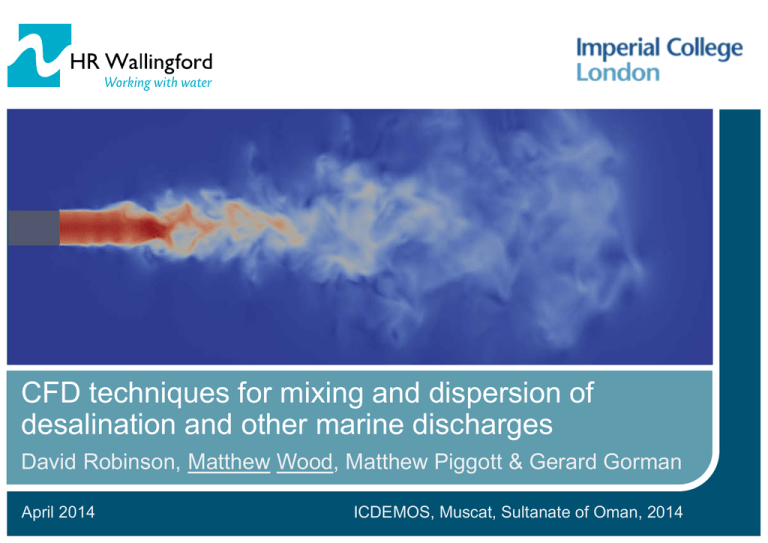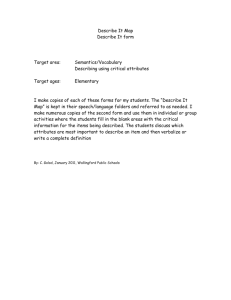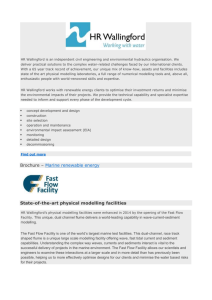CFD techniques for mixing and dispersion of
advertisement

CFD techniques for mixing and dispersion of desalination and other marine discharges David Robinson, Matthew Wood, Matthew Piggott & Gerard Gorman April 2014 ICDEMOS, Muscat, Sultanate of Oman, 2014 Content Background and motivation CFD: a tool for dispersion modelling Preliminary results Planned work April 2014 © HR Wallingford 2014 Motivation Desal / IWPP discharge plumes Benthic thermal-saline impact Dispersion prediction is vital for: EIA Engineering studies (outfall design, recirculation) April 2014 © HR Wallingford 2014 HR Wallingford in Oman April 2014 © HR Wallingford 2014 Dispersion modelling approaches Far-field dispersion Model coupling Near-field dilution (mixing zone) April 2014 © HR Wallingford 2014 Validated procedure Coupled studies are common HR Wallingford framework: “Dense Jet Assessment Procedure”, Wood & Mead (2008) Validated against newly available mid-/far-field data: “Validation of computational models for hypersaline and other dense marine discharges”, Wood et al, (2014) April 2014 © HR Wallingford 2014 Benefits & drawbacks Benefits: Methods generally work well for smaller discharges: Simple exchanges of mass & momentum Relatively quick to implement Drawbacks Plume interactions / neighbouring facilities : Barka 2-way exchange of pollutant concentrations is challenging Potential solution: CFD Computing power increases Adaptive meshing techniques Seamless coverage of the entire domain April 2014 Sohar © HR Wallingford 2014 CFD History – near-field Fluidity: Open-source, developed by Imperial Navier-Stokes on 3D unstructured meshes Discretisation: Finite element & control volume Mesh adaptivity Key differentiator – multi-scale: 3D CFD model + efficient coastal flow modelling system Used to simulate ocean and tidal flows April 2014 © HR Wallingford 2014 PhD research Long-term goals: Extend Fluidity’s multi-scale capabilities a fully integrated CFD hydrodynamic & pollutant dispersion model First stage: Explore near-field abilities Horizontal buoyant jet Angled dense jet Compared predictions with published laboratory data, or validated integral models. April 2014 © HR Wallingford 2014 Near-field test cases Parameter Inlet diameter (mm) Densimetric Froude number, F Reynolds number References for comparison Parameters for comparison • • Horizontal buoyant jet Angled dense jet 9.4 10.7 6000 3.3 21.3 2500 CorJet integral model Experimental data Centreline trajectory Mean axial velocity decay • • • Centreline terminal rise height Bottom impact distance Minimum impact dilution Zt Xi April 2014 Si © HR Wallingford 2014 Numerical methods Unstructured tetrahedral elements Turbulence: k-ε V-LES Adaptive time-stepping and meshing April 2014 © HR Wallingford 2014 Horizontal buoyant jet April 2014 © HR Wallingford 2014 Horizontal buoyant jet Centreline trajectory Centreline velocity decay April 2014 © HR Wallingford 2014 Angled dense jet April 2014 © HR Wallingford 2014 Angled dense jet Terminal rise height Impact distance Impact dilution Zeitoun et al. (1972) Roberts et al. (1997) Nemlioglu & Roberts (2006) Cipollina et al. (2005) Kikkert et al. (2007) Papakonstantis et al. (2011a and 2011b) April 2014 k1 = zt/dF 1.77 1.6 1.68 k2 = xi/dF 3.19 2.4 3.25 2.25 2.72 2.75 k3 = Si/F 1.12 1.6 +/- 0.12 1.7 1.81 1.68 +/- 0.1 © HR Wallingford 2014 Summary HR Wallingford uses a validated coupled modelling procedure involving Hydrodynamic models Near-field models Future will involve more CFD Preliminary work with Imperial College is encouraging: Buoyant jet compares well (trajectories and dilutions) Dense case requires mesh refinement Next steps of PhD: Adapt mesh to far-field Range of ambient currents Multiport diffusers April 2014 © HR Wallingford 2014 Thank you! Matthew Wood Principal Scientist HR Wallingford m.wood@hrwallingford.com David Robinson Imperial College London d.robinson12@imperial.ac.uk January 2014 Page 17 © HR Wallingford 2014







